
Homer Dodge Martin stands as a significant, albeit sometimes overlooked, figure in the landscape of nineteenth-century American art. His career charts a fascinating course from the detailed realism of the Hudson River School to the more subjective and atmospheric approaches influenced by European movements, particularly the Barbizon School and Impressionism. Martin's life and work reflect the broader shifts occurring in American art as it sought its own voice while engaging with international trends. His paintings, often imbued with a quiet, poetic melancholy, capture a unique sensibility towards nature, evolving significantly over his lifetime.
Early Life and Artistic Beginnings
Homer Dodge Martin was born in Albany, New York, on October 28, 1836. His father was a carpenter, and young Martin initially seemed destined for a similar trade, beginning work in his father's shop around the age of thirteen. However, his innate artistic inclinations soon became apparent. Though largely self-taught in his formative years, he demonstrated a natural aptitude for drawing and observing the world around him. Albany, situated near the scenic Hudson River Valley and the Catskill Mountains, provided ample inspiration for a budding landscape painter.
Recognizing his talent, Martin sought formal instruction, albeit briefly. Around the age of twenty, in the mid-1850s, he studied for a short period with James McDougal Hart. Hart, along with his brother William Hart, was a prominent figure associated with the second generation of the Hudson River School. This initial training grounded Martin in the prevailing artistic style of the time, which emphasized detailed observation, topographical accuracy, and a reverence for the American wilderness. This early exposure to the Hudson River School ethos would shape the initial phase of his artistic output.
The Hudson River School Influence
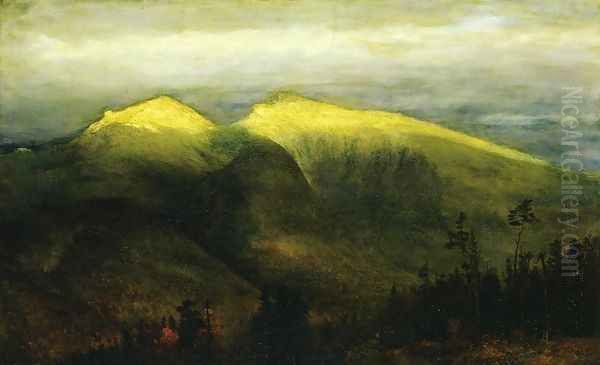
Martin's early works, created during the late 1850s and 1860s, clearly show the influence of his training and the dominant Hudson River School aesthetic. This movement, considered the first coherent school of American art, celebrated the unique beauty and grandeur of the American landscape. Artists like Thomas Cole, the movement's founder, and his successors such as Asher B. Durand, Frederic Edwin Church, Sanford Robinson Gifford, and John Frederick Kensett, sought to capture not just the look of the landscape, but also its spiritual and national significance.
Martin's paintings from this period often depict recognizable locations in the Northeast, particularly the Adirondack, Catskill, and White Mountains. They are characterized by careful draftsmanship, attention to detail in rendering foliage, rocks, and water, and often feature panoramic compositions. Works like In the Housatonic Valley exemplify this phase, showcasing a commitment to representing the specific character of the American scene with clarity and precision, aligning him with contemporaries like the Hart brothers and Gifford. He absorbed the techniques and philosophies of the school, focusing on capturing the sublime and picturesque aspects of nature.
New York City and Professional Development
In 1862, seeking greater opportunities and immersion in the art world, Martin moved to New York City. This was a crucial step for his professional development. He took space in the famed Tenth Street Studio Building, a hub for artists at the time. This building housed or had housed studios for many leading figures, including Church, Albert Bierstadt, Gifford, Kensett, and later William Merritt Chase, placing Martin at the center of the American art scene. He also studied and worked for a time in the studio of James Smillie, another artist known for his detailed landscape engravings and paintings.
During the 1860s and 1870s, Martin actively sought recognition within the established art institutions. He began exhibiting his work at the prestigious National Academy of Design, a critical venue for artists seeking patronage and critical notice. His efforts were rewarded; he was elected an Associate Member of the National Academy in 1868 and elevated to the status of full Academician in 1874. This affiliation marked his acceptance within the mainstream art community of New York. He was also part of the bohemian circle associated with Pfaff's beer cellar, a gathering place for writers and artists, which included figures like Winslow Homer.
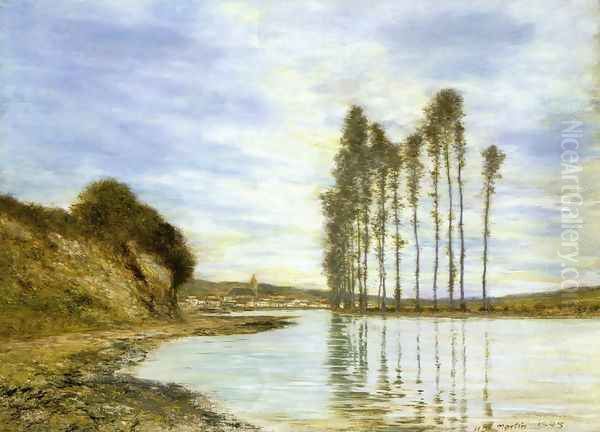
Despite these affiliations, Martin's path began to diverge from the strictures of the Hudson River School. Along with other younger artists, he grew interested in newer artistic currents emerging from Europe. This restlessness contributed to his involvement in the founding of the Society of American Artists in 1877. This organization was formed by artists who felt the National Academy of Design was too conservative and sought a venue more open to diverse styles, particularly those influenced by European training and aesthetics. This move signaled Martin's own evolving artistic perspective.
European Travels and a Shift in Style
A pivotal moment in Martin's artistic evolution came with his first trip to Europe in 1876. Traveling through England, Switzerland, and Italy, he was particularly drawn to France. This journey exposed him directly to the works of the French Barbizon School painters and the burgeoning Impressionist movement. The encounter had a profound impact, challenging the detailed, topographical approach he had practiced and opening his eyes to more subjective and atmospheric ways of interpreting landscape.
The Barbizon painters, such as Jean-Baptiste-Camille Corot, Jean-François Millet, Théodore Rousseau, and Charles-François Daubigny, worked in the Forest of Fontainebleau near Paris. They favored intimate, often moody depictions of rural landscapes, emphasizing tonal harmony, looser brushwork, and the artist's emotional response to nature over precise detail. Their work represented a move away from the idealized or dramatic landscapes of Neoclassicism and Romanticism towards a more direct, humble engagement with the everyday countryside.
Martin returned to Europe for an extended period from 1882 to 1886, spending much of this time living and working in France. He resided primarily in Normandy, a region popular with artists, staying in places like Villerville and Honfleur. He also spent time at the Étaples art colony on the coast. During these years, he immersed himself further in the French artistic environment, solidifying the stylistic changes that had begun after his first trip. He reportedly met artists associated with these movements, potentially including figures like Camille Pissarro, although direct collaborations are not well documented.
The Barbizon Influence Deepens
The influence of the Barbizon School became increasingly evident in Martin's work from the late 1870s onwards. His brushwork loosened considerably, becoming more expressive and less concerned with minute description. He began to prioritize mood and atmosphere, often choosing simpler compositions and focusing on the interplay of light and shadow. His palette sometimes shifted towards more muted, tonal harmonies, reflecting the Barbizon interest in capturing specific times of day or weather conditions.
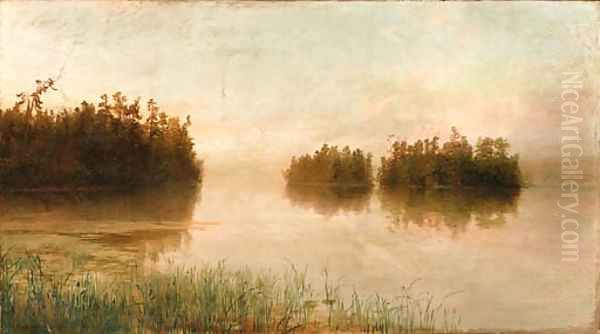
This shift aligned Martin with other American artists who were similarly drawn to Barbizon aesthetics, most notably George Inness and Alexander Helwig Wyant. Like them, Martin sought to imbue his landscapes with a sense of poetry and personal feeling, moving beyond mere representation. Works created during or after his time in France, such as Cottage in the Forest (1886), clearly demonstrate this evolution. The focus is less on the specific details of the scene and more on the overall feeling, the texture of the paint, and the subtle gradations of color and tone.
Martin's interpretation of Barbizon principles was distinctly his own. While Inness often pursued a more overtly spiritual or mystical quality, and Wyant focused on quiet, intimate woodland scenes, Martin developed a characteristic sense of melancholy and quiet grandeur. His landscapes often feel introspective, reflecting a deep, personal connection to the natural world filtered through memory and emotion.
Towards Impressionism and Tonalism
While Martin absorbed lessons from the Barbizon painters, he was also aware of Impressionism. His later works show an increased interest in the effects of light and sometimes employ a brighter palette and more broken brushwork, suggesting an engagement with Impressionist ideas. He is sometimes cited as one of the early pioneers helping to introduce Impressionistic tendencies into American art. However, Martin never fully adopted the scientific color theories or the emphasis on capturing fleeting moments with high-keyed color that characterized core French Impressionists like Claude Monet or Alfred Sisley.
Instead, Martin's late style is often more accurately described as Tonalism. Tonalism was a related but distinct American movement that emerged in the late 19th century, sharing roots with Barbizon influence. Tonalist painters, including Martin, Inness, Wyant, and Dwight William Tryon, favored intimate landscapes rendered in soft focus, with limited palettes dominated by muted tones of green, brown, gray, and blue. They emphasized atmosphere, mood, and suggestion over detail, often depicting scenes at twilight, dawn, or in hazy conditions to evoke a sense of quiet contemplation and mystery.
A significant factor influencing Martin's later style was his deteriorating eyesight. He suffered from progressive vision loss, likely due to cataracts, which became particularly severe in his final years. This physical challenge paradoxically may have contributed to the strength of his late work. Forced to rely more on memory and imagination than direct observation, his paintings became increasingly simplified, focusing on essential forms, broad masses of color, and the overall emotional impact of the scene. This led to some of his most powerful and evocative creations.
Later Years, Key Works, and Legacy
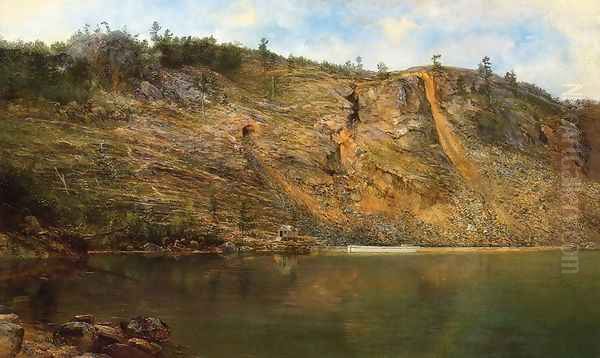
Despite growing critical interest in his evolving style among some circles, Martin struggled for financial success throughout much of his career. His more subjective, less detailed works did not always find favor with patrons accustomed to the Hudson River School aesthetic. To supplement his income, he occasionally undertook illustration work, contributing to publications like Every Saturday and illustrating poetry, such as William Cullen Bryant's "The Snow Shower" for the volume Winter Poems (1871).
Martin also reportedly experienced periods of creative block, finding it difficult to paint unless deeply inspired. An anecdote, possibly apocryphal or exaggerated, tells of fellow artist Edward Gay creating a caricature titled "Homer Hard At Work," depicting Martin dozing in the sun, highlighting these fallow periods.
In 1893, suffering from declining health and worsening eyesight, Martin moved with his wife from New York to St. Paul, Minnesota. The change of scenery was sought partly for health reasons. Despite being nearly blind, he continued to paint, working largely from memory and earlier sketches. It was during this challenging final period in St. Paul that he created some of his most celebrated masterpieces.
Among these late works, Harp of the Winds: A View on the Seine (c. 1895), now in the collection of the Metropolitan Museum of Art, is perhaps his most famous painting. Created from memory years after his time in France, it depicts a row of tall, slender poplar trees along the riverbank against a luminous evening sky. The painting is a quintessential example of Tonalism, characterized by its simplified composition, delicate color harmonies, soft atmosphere, and deeply poetic mood. The title itself evokes a sense of musicality and lyrical beauty.
Another significant late work is Adirondack Scenery (also sometimes identified with Lake Sanford, c. 1895). Returning to a region he had painted frequently in his earlier Hudson River School style, this late interpretation shows the profound transformation in his approach. The details are suppressed in favor of broad, evocative shapes and a powerful sense of atmosphere, conveying the solemn grandeur of the wilderness through a highly personal lens. Other notable works reflecting his mature style include Sand Dunes of Lake Ontario and views of the White Mountains.
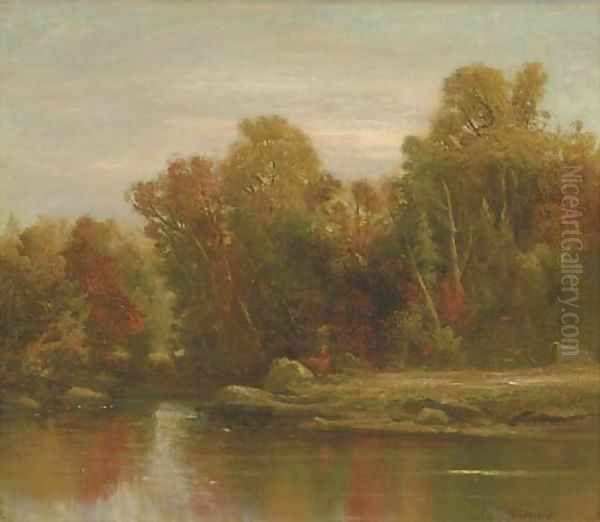
Homer Dodge Martin died in St. Paul on February 12, 1897. While not widely acclaimed during his lifetime, his reputation grew significantly after his death. Critics and collectors began to appreciate the unique sensitivity and poetic depth of his later work. Memorial exhibitions helped solidify his standing, and his paintings entered major museum collections, including the Metropolitan Museum of Art, the National Academy of Design, the Cleveland Museum of Art, and many others.
Conclusion: A Bridge Between Styles
Homer Dodge Martin occupies a vital place in the history of American art as a transitional figure. His artistic journey mirrors the broader evolution of American landscape painting in the latter half of the nineteenth century. Starting firmly within the detailed realism of the Hudson River School, he absorbed the influence of the French Barbizon movement, developing a more subjective, moody, and atmospheric style. His late works, created under the duress of failing eyesight, represent a culmination of this development, achieving a profound Tonalist poetry.
While perhaps less famous than contemporaries like Winslow Homer or George Inness, Martin's contribution is significant. He navigated the complex currents of native tradition and international influence, forging a distinctive artistic identity. His paintings offer a unique blend of observed nature and introspective feeling, capturing the American landscape not just as a place of grandeur, but as a source of quiet contemplation and enduring emotional resonance. His work stands as a testament to an artist who continually evolved, ultimately finding his most powerful voice in the evocative landscapes of memory and mood.